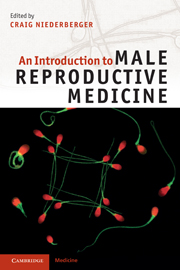
- Cited by 3
-
Cited byCrossref Citations
This Book has been cited by the following publications. This list is generated based on data provided by Crossref.
Agolah, Dennis 2022. Radiopaedia.org.
Nunes, Diana C. Ribeiro, João C. Alves, Marco G. Oliveira, Pedro F. and Bernardino, Raquel L. 2023. Male Sex Hormones, Metabolic Syndrome, and Aquaporins: A Triad of Players in Male (in)Fertility. International Journal of Molecular Sciences, Vol. 24, Issue. 3, p. 1960.
Fontana, Laura Sirchia, Silvia M. Pesenti, Chiara Colpi, Giovanni Maria and Miozzo, Monica R. 2024. Non-invasive biomarkers for sperm retrieval in non-obstructive patients: a comprehensive review. Frontiers in Endocrinology, Vol. 15, Issue. ,
- Publisher:
- Cambridge University Press
- Online publication date:
- May 2011
- Print publication year:
- 2011
- Online ISBN:
- 9780511736254


